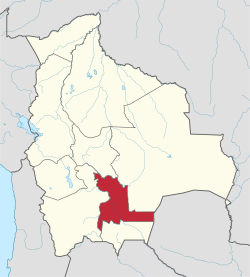Sucre
Sucre (Spanish: [ˈsukɾe]) is the constitutional capital of Bolivia, the capital of the Chuquisaca Department and the 6th most populated city in Bolivia. Located in the south-central part of the country, Sucre lies at an elevation of 2,810 meters (9,214 feet). This relatively high altitude gives the city a subtropical highland climate with cool temperates year-round.
Sucre | |
|---|---|
City | |
.jpg) Sucre, Capital of Bolivia | |
 Flag Seal | |
| Nickname(s): La Ciudad de los cuatro Nombres(The City of the four names) | |
| Motto(s): Aqui nació la Libertad(Freedom was born here) | |
 Sucre Location of Sucre within Bolivia. 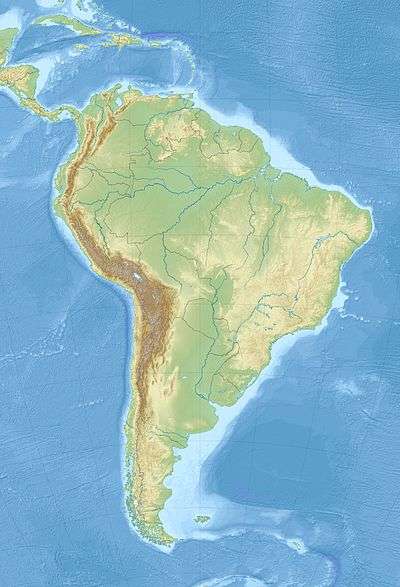 Sucre Sucre (South America) | |
| Coordinates: 19°3′0″S 65°15′0″W | |
| Country | |
| Department | |
| Province | Oropeza Province |
| Founded | 1538
|
| Founded by | Pedro Anzures as “La Plata” in 1538 |
| Government | |
| • Type | C.S. Municipal Autonomous Government |
| • Mayor | Rosario López Rojo de Aparicio |
| Area | |
| • Total | 1,768 km2 (683 sq mi) |
| Elevation | 2,810 m (9,220 ft) |
| Population (2011) | |
| • Total | 300,000 |
| • Density | 170/km2 (440/sq mi) |
| Demonym(s) | Capitalino (a) Sucrense |
| Time zone | UTC−04:00 (BOT) |
| Area code | (+591) 4 |
| Climate | Cwb |
| Website | www |
| Official name | Historic City of Sucre |
| Criteria | Cultural: iv |
| Reference | 566 |
| Inscription | 1991 (15th session) |
Its pre-Columbian name was Chuquisaca; during the Spanish Empire it was called La Plata.
Before the arrival of the Spanish, the city of Chuquisaca had its own autonomy with respect to the Inca Empire (the Charcas were the only people that did not pay the ransom for the Inca captive).
History
On November 30, 1538, Sucre was founded under the name Ciudad de la Plata de la Nueva Toledo (City of Silver of New Toledo) by Pedro Anzures, Marqués de Campo Redondo. In 1559, the Spanish King Philip II established the Audiencia de Charcas in La Plata with authority over an area which covers what is now Paraguay, southeastern Peru, Northern Chile and Argentina, and much of Bolivia. The Audiencia de Charcas was a subdivision of the Viceroyalty of Peru until 1776, when it was transferred to the newly created Viceroyalty of the Río de la Plata. In 1601 the Recoleta Monastery was founded by the Franciscans and in 1609 an archbishopric was founded in the city. In 1624 St Francis Xavier University of Chuquisaca was founded.
Very much a Spanish city during the colonial era, the narrow streets of the city centre are organised in a grid, reflecting the Andalusian culture that is embodied in the architecture of the city's great houses and numerous convents and churches. Sucre remains the seat of the Roman Catholic Church in Bolivia, and a common sight is members of religious orders dressed in traditional costume. For much of its colonial history, Sucre's temperate climate was preferred by the Spanish royalty and wealthy families involved in silver trade coming from Potosí. Testament to this is the Glorieta Castle. Sucre's University (Universidad Mayor Real y Pontificia de San Francisco Xavier de Chuquisaca) is one of the oldest universities in the new world.
.jpg)
On May 25, 1809 the Bolivian independence movement was started with the ringing of the bell of the Basilica of Saint Francisco. This bell was rung to the point of breakage, but it can still be found in the Basilica today: it is one of the most precious relics of the city. Until the 19th century, La Plata was the judicial, religious and cultural centre of the region. It was proclaimed provisional capital of the newly independent Alto Peru (later, Bolivia) in July 1826.[1] On July 12, 1839, President José Miguel de Velasco proclaimed a law naming the city as the capital of Bolivia, and renaming it in honor of the revolutionary leader Antonio José de Sucre.[1] After the economic decline of Potosí and its silver industry, Sucre lost the Bolivian seat of government when it was moved to La Paz in 1898. Many argue Sucre was the location of the beginning of the Latin American independence movement against Spain. The first "Grito Libertario" (Shout for Freedom) in any Western Hemisphere Spanish colony is said to have taken place in Sucre in 1809. From that point of view, Bolivia was the last Spanish imperial territory in South America to gain its independence, in 1825. In 1991 Sucre became a UNESCO World Heritage Site.
The city attracts thousands of tourists every year due to its well-preserved downtown with buildings from the 18th and 19th centuries. Nestled at the foot of the twin hills of Churuquella and Sika Sika, Sucre is the gateway to numerous small villages that date from the colonial era, the most well-known of which is Tarabuco, home of the colorful "Pujllay" festival held each March. Most of these villagers are members of one of the indigenous ethnicities. Many dress in clothing distinctive to their respective villages.
Government
Together with La Paz, Sucre is one of two governmental centers of Bolivia: It is the seat of the judiciary, where the Supreme Court of Justice is located. As designated in the Constitution of Bolivia, Sucre is the true capital of the nation, while La Paz is the seat of government. Sucre is also the capital city of the department of Chuquisaca.
The government of the City of Sucre is divided into executive and legislative branches. The Mayor of Sucre is the executive head of the city government, elected for a term of five years by general election. The legislative branch consists of the Municipal Council, which elects a President, Vice President and Secretary from a group of eleven members.
The mayor of Sucre is Iván Arciénega, who defeated former mayor Jaime Barrón in elections held on March 30, 2015; he took office on May 25.[2]
| Date Began | Date Ended | Mayor | Party | Notes |
|---|---|---|---|---|
| Nov 2008 | Aydeé Nava | PAÍS | ||
| Nov 2008 | May 30, 2010 | Hugo Loayza | MBL | Assumed office after Nava was indicted on corruption charges |
| May 30, 2010 | June 18, 2010 | Jaime Barrón Poveda | PAÍS | Elected in regional election on April 4, 2010 |
| June 22, 2010 | January 10, 2011 | Verónica Berríos | MAS | Designated as interim Mayor by Sucre's Council in Resolution 335/10 after Barrón was indicted on charges of organizing the violence of 24 May 2008,[3] with the support of MAS, New Citizen Alternative, and Domingo Martínez.[4] |
| January 10, 2011 | January 27, 2011 | José Santos Romero | MAS | Designated as interim Mayor by Sucre's Council in Resolution 03/11,[3] with three MAS votes (but not Berríos' alternate), four PAÍS votes, and that of Lourdes Millares.[4] |
| July 27, 2011 | January 31, 2012 | Verónica Berríos | MAS | Restored to office when the Guarantees Tribunal of Chuquisaca's Superior Court of Justice annulled Resolution 03/11[3] |
| January 31, 2012 | May 25, 2015 | Moisés Torres Chivé | Renewing Freedom and Democracy (LIDER) | Elected in 2011 special election[5] |
| May 25, 2015 | Incumbent | Iván Arciénega | MAS | Elected in 2015 municipal election[2] |
The Municipal Council was elected in the regional election of April 4, 2010. The election was by proportional representation with the Pact of Social Integration and the Movement Towards Socialism gaining the largest and second largest shares of the vote.
The council elected in April 2010 and seated in late December 2010 is as follows:
| Office | Council Member | Biography | Party | |
|---|---|---|---|---|
| President | Domingo Martínez Cáceres | Agricultural engineer, former Sub-Mayor, previous Council President, docent in the Agronomy Faculty at UMRPSFXCH. | Onward, Neighbors (ran with Sucre First) | |
| Vice President | Germán Gutiérrez Gantier | Lawyer, former Mayor of Sucre, former national Deputy, former member of the Judicial Council, docent | Pact of Social Integration | |
| Secretary | Arminda Corina Herrera Gonzales | Teacher, Constituent Assembly member for Chuquisaca and former MAS member | New Citizen Alternative | |
| Nelson Guzmán Fernández | Communicator, law student, leader of Federación Universitaria Local and the University Club. | Pact of Social Integration | ||
| Susy Barrios Quiroz | Psychologist, former Sub-Mayor of Districts 2 and 5, President of Feminine Civic Committee of Chuquisaca | Pact of Social Integration | ||
| Norma Rojas Salazar | Executive Secretary of Bolivian Red Cross and neighborhood leader | Pact of Social Integration | ||
| Juán Nacer Villagómez Ledezma | Public health doctor, former docent, former functionary of the Health Ministry and former chief of the Planning Unit of the Departmental Health Service | MAS-IPSP | ||
| Verónica Berríos chosen as interim Mayor 19 June 2010 Vladimir Paca Lezano alternate serving since June 2010 |
Berrios: Laboratory worker, lawyer, sociology student |
MAS-IPSP | ||
| José Santos Romero | Campesino leader, former leader of Chaunaca Subcentral of the campesion federation, and member of the Association of Milk Producers of Potolo | MAS-IPSP | ||
| Marlene Rosales Valverde | Businesswoman and leader of Fourth Federations of Shopkeepers of Sucre. | MAS-IPSP | ||
| Lourdes Millares | Lawyer, former national Deputy for NFR and former head of PODEMOS parliamentary delegation | Pact of Social Integration (ran with Sucre First) | ||
| Sources: "Alcalde electo en Sucre sólo tendrá cuatro concejales". Correo del Sur. April 6, 2010. Retrieved February 3, 2011. "Crisis institucional se apodera del flamante gobierno municipal de Sucre". Los Tiempos. June 2, 2010. Archived from the original on June 4, 2010. Retrieved February 3, 2011. | ||||
Geography and territorial organization
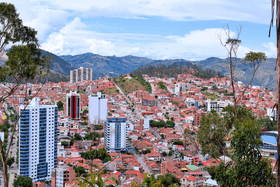
Sucre is divided into eight numbered districts: the first five of these are urban districts, while Districts 6, 7, and 8 are rural districts. Each is administered by a Sub-Mayor (Spanish: Subalcalde), appointed by the Mayor of Sucre. The rural districts include numerous rural communities outside the urban area.
Sucre is served by Alcantari Airport, situated 30 km (19 mi) to the South.
Climate
Sucre has a subtropical highland climate (Köppen: Cwb),[6] with mild temperatures year round.
The highest record temperature was 34.7 °C (94.5 °F) while the lowest record temperature was −6 °C (21 °F)
| Climate data for Sucre, Bolivia | |||||||||||||
|---|---|---|---|---|---|---|---|---|---|---|---|---|---|
| Month | Jan | Feb | Mar | Apr | May | Jun | Jul | Aug | Sep | Oct | Nov | Dec | Year |
| Record high °C (°F) | 32.8 (91.0) |
32.2 (90.0) |
31.1 (88.0) |
31.1 (88.0) |
32.8 (91.0) |
32.8 (91.0) |
30.0 (86.0) |
27.8 (82.0) |
31.1 (88.0) |
32.2 (90.0) |
33.9 (93.0) |
28.9 (84.0) |
33.9 (93.0) |
| Average high °C (°F) | 19.5 (67.1) |
19.0 (66.2) |
19.4 (66.9) |
19.3 (66.7) |
19.6 (67.3) |
19.1 (66.4) |
19.4 (66.9) |
19.9 (67.8) |
20.6 (69.1) |
20.8 (69.4) |
21.2 (70.2) |
20.0 (68.0) |
19.8 (67.6) |
| Daily mean °C (°F) | 16.2 (61.2) |
15.7 (60.3) |
15.8 (60.4) |
15.5 (59.9) |
14.9 (58.8) |
13.8 (56.8) |
13.9 (57.0) |
14.9 (58.8) |
16.2 (61.2) |
16.9 (62.4) |
17.3 (63.1) |
16.7 (62.1) |
15.6 (60.1) |
| Average low °C (°F) | 12.8 (55.0) |
12.3 (54.1) |
12.2 (54.0) |
11.6 (52.9) |
10.2 (50.4) |
8.5 (47.3) |
8.3 (46.9) |
9.9 (49.8) |
11.2 (52.2) |
12.4 (54.3) |
12.8 (55.0) |
12.9 (55.2) |
11.3 (52.3) |
| Record low °C (°F) | 4.4 (39.9) |
5.0 (41.0) |
3.3 (37.9) |
1.7 (35.1) |
−3.9 (25.0) |
−2.8 (27.0) |
−4.4 (24.1) |
−2.2 (28.0) |
−1.7 (28.9) |
−3.3 (26.1) |
−3.3 (26.1) |
−1.1 (30.0) |
−4.4 (24.1) |
| Average precipitation mm (inches) | 150 (5.9) |
126 (5.0) |
108 (4.3) |
46 (1.8) |
10 (0.4) |
4 (0.2) |
2 (0.1) |
14 (0.6) |
23 (0.9) |
56 (2.2) |
72 (2.8) |
124 (4.9) |
735 (28.9) |
| Average precipitation days (≥ 1.0 mm) | 15 | 13 | 12 | 5 | 1 | 1 | 0 | 1 | 4 | 8 | 10 | 12 | 82 |
| Average relative humidity (%) | 67 | 70 | 68 | 62 | 46 | 43 | 39 | 44 | 46 | 47 | 52 | 60 | 54 |
| Source: Deutscher Wetterdienst[7] | |||||||||||||
The City of Four Names
Each of the well known names represent a specific era of the city's history.
- Charcas was the indigenous name for the place upon which the Spaniards built the colonial city.
- La Plata was the name given to the emerging Hispanic city of privilege and honor.
- The name Chuquisaca was bestowed upon the city during the independence era.
- Sucre honors the great marshal of the Battle of Ayacucho (December 9, 1824), Antonio José de Sucre.
- "La Ciudad Blanca" is a nickname that was bestowed upon the city because many of the colonial style houses and structures are painted white.
Sports
Sucre has the most important sport facilities in Bolivia, and the most practiced sport in the city is football. Sucre has the second-biggest football and Olympic stadium in the country, the Estadio Patria. As of the 2019 Apertura, the 2008 champion club Universitario de Sucre was relegated from the Bolivian professional league, leaving the city without a first-division team.
Other sports are also practiced, such as swimming at la Piscina Bolivariana, basketball at numerous courts around the city, as well as taekwondo, kung fu, volleyball, tennis and racquetball.
Education
Sucre is home to the second oldest public university in the Americas, the Universidad Mayor Real y Pontificia de San Francisco Xavier de Chuquisaca; often abbreviated USFX. The university draws students both nationally and internationally, and different departments can be found scattered around the city. Degree areas at USFX include law, political science, medicine, odontology, chemistry, business administration, financial sciences, and more.[8]
The city also features other academic institutions such as a campus of the private university Universidad Privada del Valle also known as Univalle, the National Teachers School (Escuela Nacional de Maestros "Mariscal Sucre"), the Universidad Privada Domingo Savio, and the Universidad Andina Simón Bolívar.
Architecture
The city of Sucre contains many old and classic buildings:
The House of Freedom
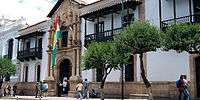
.jpg)
Built in 1621, it is perhaps the most important building of the nation. The republic was founded in this building by Simón Bolívar who wrote the Bolivian Constitution.
The "Salón de la Independencia" houses the Bolivian Declaration of Independence.
National Library
Built on the same year of the foundation of the Republic, it is the first and the most important historical, bibliographical and documentation center of the country. The National Library has documents that date from 16th century.[9]
Metropolitan Cathedral
Built between 1559 and 1712, the cathedral has the "Museo Catedraliceo" which is the first and most important religious museum of the country. The "Pinacoteca" has a vast collection of paintings by Colonial and Republican masters and also by Europeans such as Bitti, Fourchaudt and Van Dyck. The Cathedral contains a vast amount of jewelry made of gold, silver and gemstones.
Archbishop's Palace
Built in 1609, was an important religious and historic institution during colonial times.
Departmental Autonomous Government of Chuquisaca
.jpg)
One of the best buildings of republican architecture, this was completed in 1896. It was the first Palace of Government of Bolivia but when the government was moved to La Paz it became the Chuquisaca Governorship Palace.
Supreme Court of Justice
On July 16, 1827 the Supreme Court of the Nation was established. Its first president was Dr. Manuel Maria Urcullo. Others prominent in its history include Dr. Pantaleon Dalence, who was twice president of the Supreme Court and through his qualities became known as the 'Father of Bolivian Justice'. This institution was installed in several places before moving to its current building. It was designed in the neoclassical style under the canons of French academicism and was inaugurated on May 25, 1945.
General Cemetery
Some of the areas date from the late nineteenth century. Ornate mausoleums, tombs and gardens with magnificent old trees populate the space that is home to the graves of important people in the arts, sciences and the history both of Bolivia and of Latin America. Because of the tranquility offered by the site, many students choose to study here.
Churches and Convents
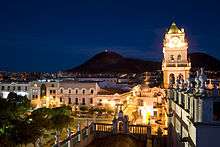
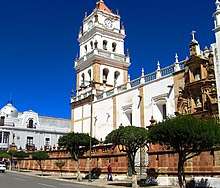
- San Felipe Nery
- San Francisco
- La Recoleta
- Santa Teresa
- Santa Clara
- Santo Domingo
- San Lazaro (The oldest church in the country and ex-Cathedral of Sucre)
- San Sebastian
- Iglesia de la Merced
- San Agustín
- Santa Mónica
- Santa Barbara
- San Miguel
Chapels
- Loreto's Chapel
- Virgen de Guadalupe
Transportation
The city is served by Alcantarí Airport with multiple domestic destinations on three commercial airlines.
Twin cities
.svg.png)




.svg.png)
See also
References
- "Sucre.", Sociedad Geográfica (1903). Diccionario geográfico del Departamento de Chuquisaca: contiene datos geográficos, históricos y estadisticos. Impr. "Bolívar" de M. Pizarro. pp. 296–97.
- Donoso, Yuvert. "Arciénega triunfa; le falta mayoría - La Razón". La Razón (1 April 2015 ed.). Retrieved May 8, 2015.
- "Fallo judicial restituye a Alcaldesa de Sucre". Los Tiempos [byline: Correo del Sur]. January 28, 2011. Archived from the original on January 30, 2011. Retrieved January 30, 2011.
- "Escándalo frena elección edil y abre paso a negociaciones". Correo del Sur. June 2, 2011. Retrieved December 13, 2011.
- "Torres ya es Alcalde de Sucre". Correo del Sur. January 31, 2012. Archived from the original on February 4, 2012. Retrieved February 6, 2012.
- "Climate: Sucre - Climate graph, Temperature graph, Climate table". Climate-Data.org. Retrieved January 5, 2014.
- "Klimatafel von Sucre, Prov. Chiquisaca / Bolivien" (PDF). Baseline climate means (1961-1990) from stations all over the world (in German). Deutscher Wetterdienst. Retrieved January 27, 2016.
- "Facultades". Universidad de San Francisco Xavier. Universidad de San Francisco Xavier. Retrieved December 5, 2019.
- Archivo y Biblioteca Nacionales de Bolivia, Anuario de Estudios Bolivianos, Archivisticos y Bibliograficos. No.14 - 2008, p.301ff
- "Home page of Cardiff Council – Cardiff's twin cities". Cardiff Council. June 15, 2010. Retrieved August 10, 2010.
External links
| Wikimedia Commons has media related to Sucre. |

- UNESCO World Heritage Site
